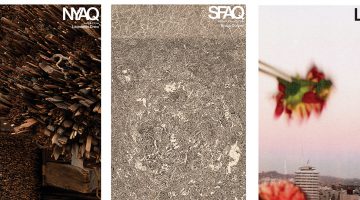Exhibition Dates: October 19 – October 19, 2013.
The idea behind c2c project space, the brainchild of artist Kirk Stoller, is (to quote directly from the website) to “invite an artist from NYC to come to San Francisco and pair him/her with a Bay Area artist to see what the duo creates.” In this inaugural iteration, Stoller has invited Vince Contarino and Zachary Royer Scholz to collaborate with and react to each others process and product.
Contarino works primarily as an abstract painter, taking the formal language of painting as a readymade against which he balances confident painterly marks and flat hard edged areas. As spontaneous or intuitive as the gestural marks may look both they and the geometric shapes are the result of a patient thoughtful process. The fascination with brushwork and gesture come through in the meticulously modulated color combinations. It is interesting to watch someone claim the idea of the slipping glimpser and locate it not in speed and spontaneity but in a focus on what can be seen how. This interest in material growing out of, but not tied to, a predetermined history is the site of crossover with Zachary Royer Scholz’s work.
Scholz has developed an elusive non-media specific practice that involves found materials chosen not for what they are but for what they can become. Choosing materials such as antique velvet or industrial shelving puts the work in a specific aesthetic category. Left unadulterated, the found materials become art only via the artists selection. But Scholz does not choose these objects just for their inherent aesthetic qualities but uses those qualities, to shift them ever so slightly outside of their categorical boundaries. After this transformation Scholz’s objects comment both on their status as readymade and on the formal problems related to more traditional sites and media.
In his article for Parachute magazine from 2000 writer Alex Coles condenses the organizing strategies available to the contemporary avant garde artist into a pithy two: “the ‘alternative’ avant-garde and the ‘mainstream’ avant-garde. One group intervenes with the everyday, and so engages with a multitude of sites and communities, the other resists (the everyday), hereby limiting art’s area of jurisdiction to traditional mediums and audiences.”
On the face of it, Contarino could be cast as being more “mainstream” avant garde, but his work presents a challenge for viewers of painting, such as how to square the history of the medium with the ambitions of an artist. He takes the sublime monumentality of expressionist abstraction, sweeping away the maudlin sentimentality to expose a more intimate and personal sublimity.
Looking at a painting like “NT/NF/12”, a work that reads much larger than its 11×14 inch dimension, the careful curation of the mark making removes the marks from the tired trope of expressive gesture, recalibrating our expectations of the language as the artist deploys it. Instead of expressivity we are seeing a series of carefully chosen readymade “objects” this time in the guise of brush strokes that are brought to and arranged on the canvas to create work that functions like an abstract painting. The four triangles that float in front of the atmospheric space, tonal echos of the carefully harmonized hues underneath, help organize the space of the canvas and give an intentionality to the tension between orderly and disheveled. The uppermost triangle the darker of two cold greys presses one side flush against the the top edge of the canvas, two points of a second triangle this one a cool green tint alight tentatively on the top and left hand edge.
This acknowledgement of the edges happens quite frequently in the paintings on display in the project space, sometimes more assertively as in “NF/NT/1” which is bound on three sides by solid colors with only a small aperture on the fourth opening the canvas to the larger world. Sometimes with a chaste embarrassment as in “NT/NF/13” with it’s collection of David Reed-like mauves, pinks and brown oranges swooping around the surface. Meanwhile the black, viridian and rose circle in the lower right hand corner leans gently against the edge as if its listening in on the world outside. While there is familiarity of investigation on each piece, it must be pointed out that the edge work makes each canvas its own world, complete as spaces unto themselves.
Scholz has chosen to work with the entire space of the apartment gallery, creating cubeoid “covers” for the furniture that normally populates the space. These interventions into the architecture and design of the space are loosely connected to Contarino’s work in their color choice a blue material, the hand built manner in which the objects are constructed nd the white frame establishing the edges. The use of tape to join the material to the frame echos Contarino’s mechanical edges, a simple connection but the installation of these cube/rectangular shaped transforms the entire gallery into a multidimensional version of one of Contarino’s paintings. Scholz and Contarino chose to remove the globes from the hanging lights in the space casting hot spots and harsh shadows about the room. And Stoller navigating Scholz’s work for the duration of the installation creates the painterly strokes of movement reminiscent of the brush strokes in Contarino’s work. This expansion from the painterly surface into the everyday site of an apartment may seem to designate Scholz as belonging to the “alternative” avant garde, but he is pushing at the edges of that idea and at the edges of his own practice in dealing with the painterly issues of color, edges and the organization of space.
The artists straddle the categories as they were defined by Alex Coles. Each artists practice pulls at its own history, pushes back on the manner it which it “must” be viewed. Instead we get to see and abstract painter working out his chosen language in the expansive concepts of the readymade and an artist who works with found objects positioning them within the formal language of painting.
-By Matthew Marchand




